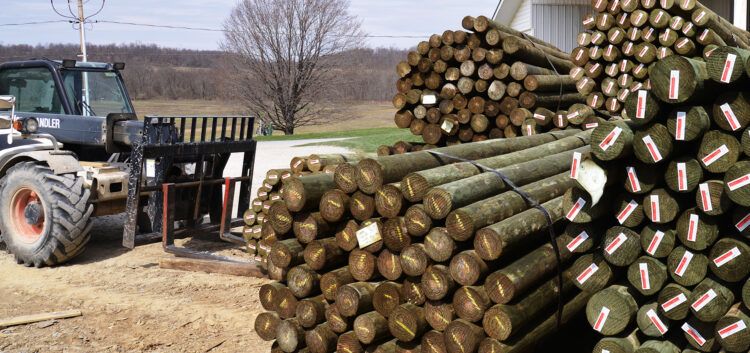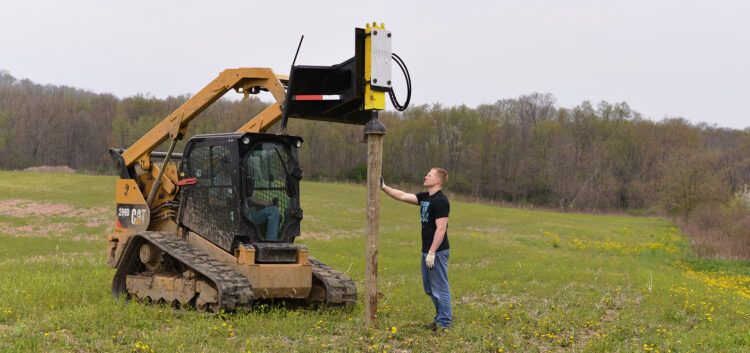Yes, it is true not all wood posts are the same. Different species of wood will last longer than others and some are better to use if you are hydraulically driving a post vs hand setting a post. By learning the differences you will be able to choose the best wood post for your needs.
In part one of this blog series we discussed how species, location of growth, knots, types of wood in the post, and form can help you determine what posts will work the best for your project.
Treatment:
Locust and cedar have natural toxins which builds as the tree grows to protect it naturally. That is why most organic farms must use a post that is chemical free like a locust or cedar post.
The species of Southern Yellow Pine and Red Pine, do not have any natural defense against rot, termite damage or insects to prevent decay, therefore the sapwood must be chemically treated to prevent this and give the post a longer life. You can only treat the sapwood you cannot treat heartwood. Check out Part 1 of this blog for more information on sapwood and heartwood.
There are a few different types of treatments that a post can go through. The best method of treatment is pressure treated. The industry standard ASTM ( American Society for Testing and Materials) for treatment for posts used in fencing is CCA .40 (Cromated Copper Arsenate.) .40 means .40 pounds of treatment per cubic foot of treatable surface.
 Stacks of differently treated posts
Stacks of differently treated posts
It is possible to get a post treated with say CCA .60 or .60 pounds of treatment per cubic foot of treatable surface, or any other specification that you require. This would be a special order and you would need to inform the sales person at the time of order and these posts would need to be custom made for you.
Diameter:
Posts come in different diameters. In the industry they can range from as small as a 2” diameter post to an 8” diameter post or even larger. We touched on diameter back in the first blog. The diameter of the post you choose will be directly related to the use of the post. Make sure you are using the correct diameter for the purpose of the post. For more details or for help with choosing the correct post call your Kencove Product Specialist at 800-536-2683.
Length:
In the fencing industry posts typically range in length from 6 1/2’ to 16’. Just like the diameter, the length of the post is directly related to the use of the post. Make sure you are using the correct length post for the use and soil condition of your fence. For more details or for help with choosing the correct post call your Kencove Product Specialist at 800-536-2683.
Installation Type:
The way you plan to install your fence posts will also be a deciding factor in the species of post that you choose. A hydraulically driven post is 7 times stronger than a hand set post. The way that the earth dissipates around and shores up around the post is tighter and stronger than hand set and tamping. When hydraulically driving a post this is where your heartwood and knot configuration come into being a factor. If you have a post that has good heartwood then the post will take the pressure of the impact of a hydraulic post driver. If the knots are sporadic then the post will also stand up to the pressure of the impact of the hydraulic post driver.
 Post being driven with a nitrogen over hydraulics style driver
Post being driven with a nitrogen over hydraulics style driver
If the post has a very small heartwood or the knots are closer together say in a ring around the post then these will be weaker posts and using a hydraulic post driver may break more readily.
Like we said not all posts are made the same, we have covered treatment, diameter, and length knowing the differences in these areas can help you start to narrow down your choices when it comes to planning your fencing project!
In the Part 3 of this blog we will cover how brace assemblies and size for number of wires can help you determine what post is right for you!
For additional assistance to ensure you are using the correct diameter and length of post contact your Kencove Product Specialist at 800-536-2683.
Disposal of Treated Wood: DISPOSE IN A LAND FILL, DO NOT BURN TREATED WOOD DO NOT SPREAD ASH OR DUST FROM TREATED WOOD ONTO GARDENS,WASH YOUR HANDS AFTER HANDLING TREATED WOOD AND BEFORE EATING OR DRINKING COMMON SENSE PRECAUTIONS




